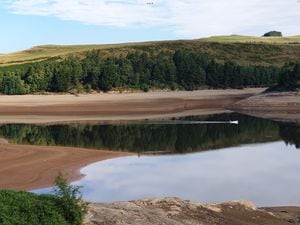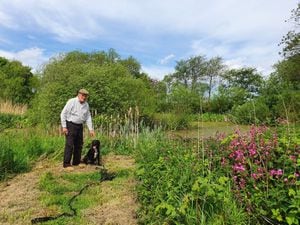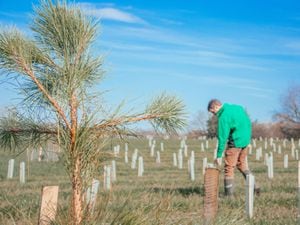Footage shows shocking water levels as reservoir supplying River Severn at lowest record this year
The main reservoir that supplies water to the River Severn is at its lowest level this year prompting a reminder to people to use water wisely.

The Clywedog reservoir in Llanidloes, Mid Wales, which releases water to run into the Severn is recording almost minus 16 metres on its depth gauge.
And an overhead video released on Twitter by an Environment Agency hydrologist shows just how low that looks.
Rob Davies said that every drop of water counted.
"Without the reservoirs releases, the Severn would be dry or a trickle downstream, especially in these drought conditions," he tweeted.
Figures produced by Natural Resources Wales, have charted a steady drop in the water level in the reservoir since June.
At 9pm on Wednesday the level stood at 15.971 metres.
Earlier this month, Natural Resources Wales, which is responsible for the Clywedog Dam, said there was a pressing need to prepare and adapt to the environmental and wider impacts of climate change.
It said it was working with the Environment Agency in England on cross border environmental and water resource issues.
The impacts of the prolonged dry weather period over recent months had led to significant concerns for the ecosystems and habitats, water supplies, land management and agriculture.
Natalie Hall, Sustainable Water Manager at Natural Resources Wales said: “While essential water supplies remain safe, the public and businesses right across Wales areas are being urged to use water wisely and manage this precious resource at this time.”
Between March and August Wales received just 56.7 per cent of its expected rainfall, the third driest six-month period since records began in 1865. In August alone, Wales received just 38 per cent of its average monthly rainfall. The Met Office has also confirmed that this summer has been the eighth warmest for Wales since 1884.
"The prolonged dry period has led to exceptionally low river flows, low groundwater levels and a decline in reservoir levels right across the country, with most well below average for the time of year. Wales has also seen higher temperatures in its waters and on land than expected for this time of year. These conditions have exacerbated pressures on our land, habitats, species, wildlife and water supplies."
"While sufficient rainfall over the autumn and winter months would go some way to replenishing rivers, lakes, groundwaters and reservoirs to normal levels by the spring, Natural Resources Wales will continue to work with Welsh Government, water companies and abstractors to ensure the needs of water users and the environment are met next year in the event of a dry autumn or winter."
"NRW has been working closely with the Environment Agency (EA) in England in relation to cross-border environmental, water resources and navigational related impacts and to give careful consideration to any drought declarations in areas which span the England-Wales border.
"NRW and the EA will be keeping these areas under close monitoring and discussing and agreeing any actions that need to be taken for these catchments."
Severn Trent has also sent out millions of texts to its customers urging them to use water wisely.
It comes as Lake Vyrnwy's water levels are suffering in the same way. The level would usually be nearly 90 per cent full in July-August, but it's now pretty much approaching half empty.





